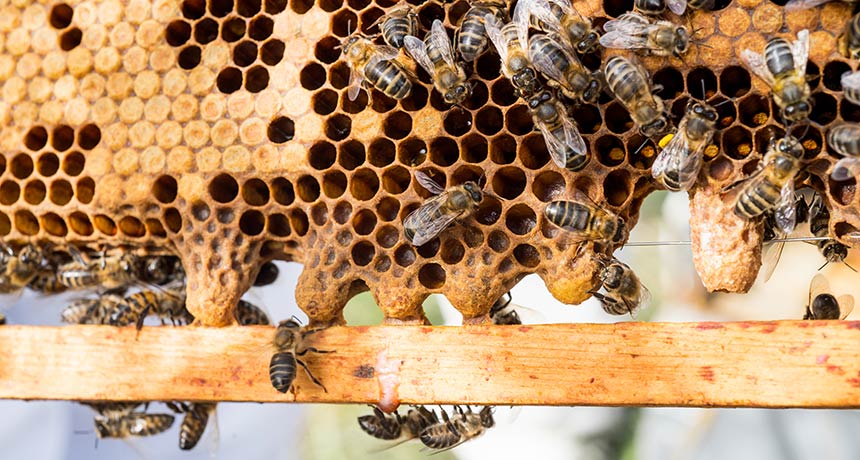How honeybees’ royal jelly might be baby glue, too

Honeybee royal jelly is food meant to be eaten on the ceiling. And it might also be glue that keeps a royal baby in an upside-down cradle.
These bees raise their queens in cells that can stay open at the bottom for days. A big blob of royal jelly, abundantly resupplied by worker bees, surrounds the larva at the ceiling. Before the food is deposited in the cell, it receives a last-minute jolt of acidity that triggers its proteins to thicken into goo, says Anja Buttstedt, a protein biochemist at Technische Universität Dresden in Germany. Basic larva-gripping tests suggest the jelly’s protein chemistry helps keep future queens from dropping out of their cells, Buttstedt and colleagues propose March 15 in Current Biology.
Suspecting the stickiness of royal jelly might serve some function, researchers tweaked its acidity. They then filled small cups with royal jelly with different pH levels and gently turned the cups upside down. At a natural royal jelly acidity of about pH 4.0, all 10 larvae dangled from their gooey blobs upside down overnight. But in jelly boosted to pH 4.8 (and thinned in the process), four of the 10 larvae dropped from the cups. At pH 5.9, all of them dropped.
Honeybees build several forms of royally oversized cells for raising a queen. Those for queens who will swarm with their workers to a new home hang from the rim of an array of regular cells. A hole stays open at the bottom of the cell until the larva nears pupation from her fat grub shape into a queen with wings. That hole at the bottom is big enough for a royal larva to fall through, confirms insect physiologist Steven Cook at the honeybee research lab in Beltsville, Md., run by the U.S. Department of Agriculture’s Agricultural Research Service.
Buttstedt and colleagues propose that the stickiness of royal jelly may be what keeps the larva in place. The team worked out how the jelly’s proteins change as it is made, and how those changes affect its consistency.
Royal jelly is secreted as a brew of proteins from the glands above a worker bee’s brain. At that point, it has a neutral pH, around 7, like water’s. The worker bee then adds fatty acids from glands in her mouthparts, which take the pH to around 4.
“It has a quite sour smell,” Buttstedt says. As for taste? “Really weird.” A steady diet of this jelly is what turns a larvae into a queen instead of a worker.
At pH 4, the jelly’s most common protein, MRJP1, goes complicated. When the protein leaves the glands above the brain, it’s clustered in groups of four along with smaller proteins called apisimins, the team found. When the acidity shifts, the MRJP1 foursomes and the apisimins hook together in slender fibers and get gluey.
“The most puzzling question,” Buttstedt says, is “why build upside-down queen cells in the first place?”